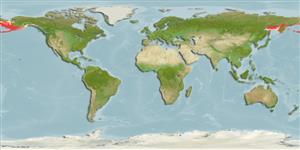Environment: milieu / climate zone / depth range / distribution range
Ecologia
marinhas demersal; intervalo de profundidade 0 - 325 m (Ref. 50610). Temperate; 65°N - 51°N, 140°E - 138°W (Ref. 57309)
North Pacific: Kotzebue Sound to the northern Sea of Japan, Sea of Okhotsk and Akun Island in the Aleutian chain (Ref. 6793); and adjacent Arctic, including Gulf of Alaska (Ref. 51659).
Tamanho / Peso / Idade
Maturity: Lm ? range ? - ? cm
Max length : 21.6 cm SL macho/indeterminado; (Ref. )
Descrição suscinta
Chaves de identificação | Morfologia | Morfometria
Espinhos dorsais (total) : 8 - 11; Raios dorsais (total) : 6 - 9; Espinhos anais: 0; Raios anais : 13 - 16. Suprapectoral plates absent. Pectoral fin with 5 rows of blackish-brown spots. Resembles O. iburia in having blackish-brown spots on the pectoral fin, but differs by having no sub pectoral plate, 42 or fewer lateral line plates, and 30 to 37 supralateral plates.
Ciclo de vida ou comportamento de acasalamento
Maturities | Reprodução | Spawnings | Egg(s) | Fecundities | Larvas
Robins, C.R., R.M. Bailey, C.E. Bond, J.R. Brooker, E.A. Lachner, R.N. Lea and W.B. Scott, 1991. Common and scientific names of fishes from the United States and Canada. Am. Fish. Soc. Spec. Publ. (20):183 p. (Ref. 3814)
Status na Lista Vermelha da UICN (Ref. 130435)
Ameaça para os humanos
Harmless
Uso pelos humanos
Ferramentas
Relatórios especiais
Baixar XML
Fontes da internet
Estimates based on models
Preferred temperature (Ref.
123201): -1.1 - 5.4, mean 1.9 °C (based on 531 cells).
Índice de diversidade filogenética (Ref.
82804): PD
50 = 0.5625 [Uniqueness, from 0.5 = low to 2.0 = high].
Bayesian length-weight: a=0.00389 (0.00180 - 0.00842), b=3.12 (2.94 - 3.30), in cm total length, based on all LWR estimates for this body shape (Ref.
93245).
Nível Trófico (Ref.
69278): 3.2 ±0.4 se; based on diet studies.
Resiliência (Ref.
120179): médio(a), tempo mínimo de duplicação da população 1,4 - 4,4 anos (Preliminary K or Fecundity.).
Fishing Vulnerability (Ref.
59153): Low vulnerability (16 of 100).
